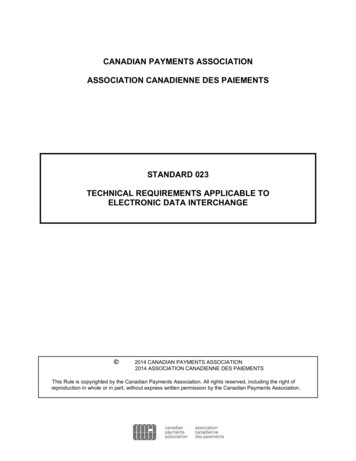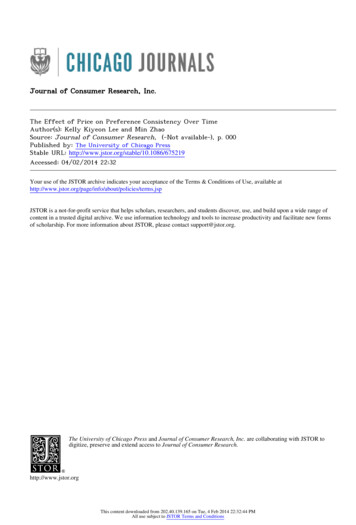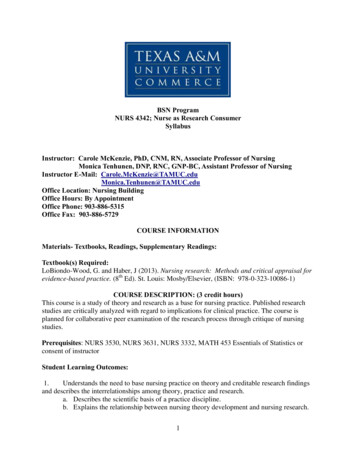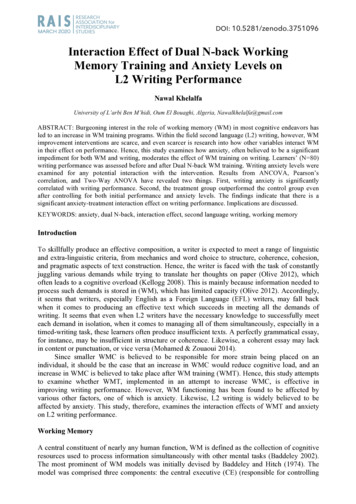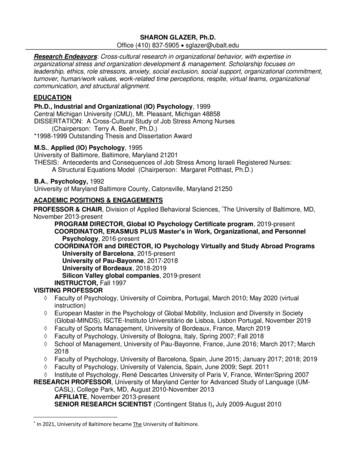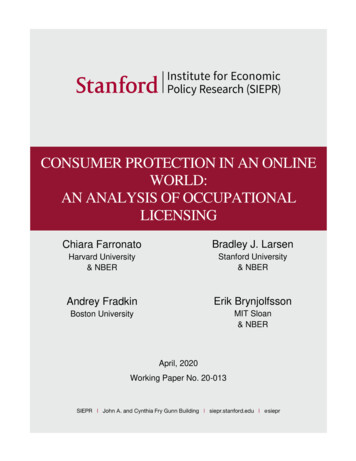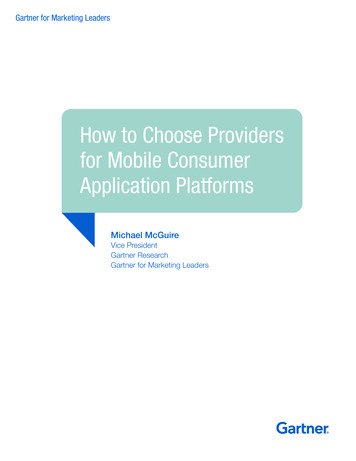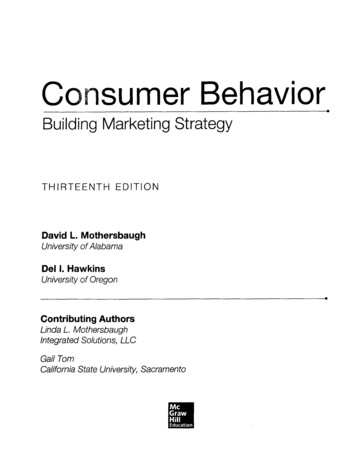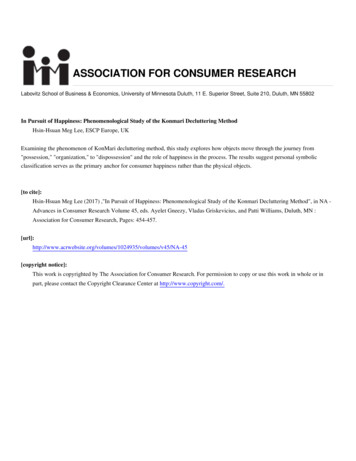
Transcription
ASSOCIATION FOR CONSUMER RESEARCHLabovitz School of Business & Economics, University of Minnesota Duluth, 11 E. Superior Street, Suite 210, Duluth, MN 55802In Pursuit of Happiness: Phenomenological Study of the Konmari Decluttering MethodHsin-Hsuan Meg Lee, ESCP Europe, UKExamining the phenomenon of KonMari decluttering method, this study explores how objects move through the journey from"possession," "organization," to "dispossession" and the role of happiness in the process. The results suggest personal symbolicclassification serves as the primary anchor for consumer happiness rather than the physical objects.[to cite]:Hsin-Hsuan Meg Lee (2017) ,"In Pursuit of Happiness: Phenomenological Study of the Konmari Decluttering Method", in NA Advances in Consumer Research Volume 45, eds. Ayelet Gneezy, Vladas Griskevicius, and Patti Williams, Duluth, MN :Association for Consumer Research, Pages: 24935/volumes/v45/NA-45[copyright notice]:This work is copyrighted by The Association for Consumer Research. For permission to copy or use this work in whole or inpart, please contact the Copyright Clearance Center at http://www.copyright.com/.
In Pursuit of Happiness: Phenomenological Study of The KonMari Decluttering MethodHsin-Hsuan Meg Lee, ESCP Europe, UKABSTRACTExamining the phenomenon of KonMari decluttering method,this study explores how objects move through the journey from“possession,” and “organization,” to “dispossession” and the role ofhappiness in the process. The results suggest personal symbolic classification serves as the primary anchor for consumer happiness ratherthan the physical objects.INTRODUCTIONHow do consumed objects move through the journey from possession to dispossession? Where do consumers find happiness inthis process? Prior research seems to center around the two extremeends. On one end, happiness can be found in consumption, both inthe form of materials and experiences, albeit to a different extent(Nicolao, Irwin, & Goodman, 2009). On the other end, consciousdispossession such as anti-consumption has also proven to influenceconsumer happiness (Cherrier, 2009). This type of mindful consumerbehavior is often thought to be aspired by the reflection of societaloverconsumption (Sheth, Sethia, & Srinivas, 2011). The notion ofoverflowing items in possession has inspired another stream of research on the household organization and the need for tidiness (e.g.,Löfgren, 2016). While the process of tidying things up is consideredmundane, the domestic order is often linked to consumer tranquility.However, little is known about how these three stages ‘possession,’‘organization,’ and ‘dispossession’ work together and how happinessis perceived and influences the decisions during the practices. Focusing on a decluttering approach, KonMari Method (Kondo, 2014),this research aims to yield insights on object-subject relationshipsbeyond what is currently available in the literature. While the primefocus of the method is to organize the domestic mess, it emphasizeson finding the joy sparked by items as the standard to decide whetherto possess or discard. This sets a proper context to explore how consumers define happiness in their decision making.LITERATURE REVIEWConsumption, Anti-consumption, and HappinessMaterialism is thought to be the primary social drive for modernconsumption. In the context, happiness is defined by the abundanceand the capability of acquisition (Richins and Dawson, 1992). Investigating the view of “money can buy happiness,” prior studies illustrate that consumption does lead to contentment. It is common forconsumers to use object ownership as a mean to satisfy their psychological (Yu, Jing, Su, Zhou & Nguyen, 2016) and functional needs(Bhardwaj, Park & Kim, 2011), reward oneself (Godey et al., 2012),signal social status (Rege, 2008), reduce negative emotions (Kempand Kopp, 2011), and consequently, increase happiness. However,many have argued that experiential purchase, in fact, induces morehappiness than material purchase (Carter & Gilovich, 2010; Dunn,Gilbert & Wilson, 2011; Nicolao, Irwin, Goodman, 2009). In particular, extraordinary experiences tend to result in a higher level ofhappiness than those ordinary ones (Bhattacharjee & Cassie, 2014).Though the direct relationship between money and happiness isweak, consumption does seem to influence one’s wellbeing.Parallel to this development, in the past decades, there are several consumer movements against over-consumption. Starting withthe notion that excessive consumption makes people unhappy (Lee& Ahn, 2016), consumers may express their resistance toward themarketplace in various forms, ranging from complaining, boycotting,voluntary simplicity to anti-consumption (Cherrier, 2009). They mayengage in these activities driven by intrinsic or extrinsic motivations.Movements such as mindful consumption (Sheth et al., 2011) andcollaborative consumption (Albinsson & Perera, 2012) are motivatedby concerns for the well-being of the environment. Consumers mayfind happiness in thinking they are contributing to the greater good.It may also come from the feeling of regaining control of oneself andreduced stress level that is related to the variety and the number ofchoices offered in the marketplace (Lee & Ahn, 2016).Symbolic Classification System and PollutionOwning too many objects and the need to organize have becomecentral in modern consumer life (Cwerner and Metcalfe, 2003). Decluttering has become a widespread practice. It may seem straightforward to remove the items from a collection when an object islosing its value, functional or hedonic. However, consumers oftenattribute the cause of having “too much” to the overall volume ratherthan specific objects, which makes it hard to choose what to discard. Also, because of the meaning that the items represent, one maybe reluctant to do so. Materiality studies suggest that while objectsare non-human entities, consumers may have a psychological andemotional attachment to their possessions. Object-centered thinkingviews things as having a life and an identity which plays a significantrole in the narratives of belonging (e.g., Zwick and Nikhilesh, 2006).This subject-object relation motivates and sustains the ongoing commitment to the labor of possession (Ekerdt & Baker, 2014).The increasing number of items tends to result in a domesticmess, which is defined as a form of symbolic pollution, that is, itemsthat are misplaced based on a self-identified system. Taking fromDouglas (1967) definition of symbolic classification system whereeverything has its own place, Dion and her colleagues (2014) studiedhow people manage the mess at home. They found people have theirsystems defining the proper places and boundaries for objects. Thosethat are “out of place” are considered untidiness. While messinessis related to positive outcomes such as creativity (Löfgren, 2016),the disorder can create stress and anxiety. It is not the object itselfthat results in such negative feelings, but rather a disruption in theclassification system that the person has created (Dion, Sabri & Guillard, 2014). According to this, knowing where to place an object athome can be both satisfying and endangering consumers’ well-being.While decluttering aims at clearing out the mess, it is also promotedas an act of restoring happiness in the household (Cherrier & Belk,2015).KonMari MethodsMarie Kondo, a Japanese organizing consultant, and her bestselling book titled “The Life Changing Magic of Tidying up” (Kondo, 2014) has led a movement of decluttering one’s possessions inpursuit of happiness. It has attracted millions of worldwide followers who consider themselves as KonMari converts (Yourgrau, 2015).There are some unique features to this method that may explain itspopularity. Kondo advertises her method as a once in a lifetime experience that by completion, people will never have clutter in the houseagain. The most critical step is to touch each item and ask oneself ifit “sparks joy.” Whether an object induces happiness serves as thesole principle whether one should own the item. Specific organizing tips are followed to help find places for every single object at454Advances in Consumer ResearchVolume 45, 2017
Advances in Consumer Research (Volume 45) / 455home. In her view, items are not just objects but things with theirarcs and narratives. For all the items that do not spark joy, Kondosuggests the readers to thank it for having served its purpose beforethrowing it away. When an item ends its journey, no one else shouldown it. Thus, the items are not for reselling or recycle, as this wouldindicate the continued attached (monetary) value from the owner.Studying how consumers applied KonMari methods to organize theirpossessions, this study investigates how people find happiness in theprocess of moving objects through possession, organization, and dispossession.METHODOLOGYTo analyze the role and the definition of happiness in the trajectory of objects, the study follows the descriptive phenomenologyresearch approach to describe the reality of the phenomenon of KonMari. This method allows a substantial representation of the subjective experience of the participants (Mick & Demoss, 1990). In-depthinterviews were conducted with 11 female adults between the age of26 and 47 who self-identified as practicing some forms of KonMarimethods. The participants were recruited through convenience andsnowball sampling strategies. One critical selection criterion of theparticipants is that they must have documented their decluttering attempts with pictures, blog articles, diaries or videos. These materials were used to prompt answers and recall their processes. Theirexperience with the KonMari method ranges from 2 months to 5years, as the book was first published in Japanese in 2011 and onlylater translated into different languages around the world. Six of theparticipants considered themselves as pure KonMari converts whofaithfully followed all steps in the method. The rest have given upat a various stage or adjusted it to their preferences. The interviewtranscripts, the verbal and visual content of the documentaries areanalyzed. An initial coding scheme was developed based on the stepsidentified in the KonMari method as well as the three key stagesof possession, organization, and dispossession in the literature. Theanalysis built on continual comparisons between the data collectedfrom different participants.ANALYSIS AND INTERPRETATIONIt is an interactive process to redefine the place of an object inone’s heart and one’s house. While the KonMari steps are linear witha rigid procedure, depending on participants’ symbolic classificationand how flexible it can be, they may experience a different level ofchallenges.Personified ObjectsIn understanding one’s true feelings toward an object, Kondorecommends followers to treat it as a person, to thank it for its service, and to feel the intangible bond with the item. Many, even theconverts, found it challenging to comprehend. Many participants rejected the idea of attaching narratives to the items, albeit understanding the logic behind it. Some were more familiar with the exercisebecause it’s natural to them: “I guess it’s a cultural thing. My parentsalways told me to respect the stuff I have, to take care of them andto appreciate their beings. Granted, I don’t normally talk to them or maybe sometimes I do. It’s not that weird” (Mai, 5 years withKonMari). The attached meanings and personalities do not seem toinfluence the process of dispossession as anticipated. In some cases,it supports the notion of discarding items: “Well, I said thank you,and that’s that. It’s a bit sad, but hey, everything has it’s time, right?Every story must come to an end. You can’t hold on to things forever.I guess I just spent longer time to say goodbye.” (Mari, 5 years withKonMari).Joy-Sparking ItemsEveryone seemed to have their own interpretation and understanding of joy-sparking. Some were clearly struggling in defininghappiness or hedonic value in items: “I just don’t get it, I’m sorry,Only God can spark joy, not stuff!” (Boudoir, 2 months with KonMari). Even without the religious view, this is still challenging forsome when concerning functional items, while others can easily justify happiness provided by the objects as it makes their life easieranyhow. On the other hand, happiness has been interpreted by theparticipants sometimes purely by the appearance, as in how they arepleasing to look at and that makes them happy. In general, happinessoften is tied to their places in the symbolic system. As a participantdescribed: “I found it hard to feel if something sparks joy, becausethey are just stuff. So I just judge by if I can imagine their place inthe house, or a place in my mind, if I will think about it in the futureand put a smile on my face, I think then that’s it.” (Karlie, 2 yearswith KonMari).Possession or DispossessionThe KonMari method suggests participants to only keep an itemif it makes them happy. Few participants who are possession-oriented believe this is a positive mindset that helps the process. Theyargued that the method eliminates the guilt feeling and force themto focus on what to keep. However, most participants found it easierto think about what to discard. Many believed the best part of thepractice is to throw away items, even though they felt guilty to tossaway usable objects. Many described the process as uplifting andrefreshing. Some even suggested it being the “best part” or the “happiest moment” in the whole exercise. Depending on ones’ symbolicclassification and the ideal volume of items that they wish to have,participants would have their preferred approach in thinking aboutwhat to possess or what to abandon. People who have a more definitefeeling in deciding what makes them happy were also more comfortable with thinking about what to keep. It seemed that the positivefeel
KonMari Methods Marie Kondo, a Japanese organizing consultant, and her best-selling book titled The Life Changing Magic of Tidying up (Kon-do, 2014) has led a movement of decluttering one s possessions in pursuit of happiness. It has attracted millions of worldwide follow-ers who consider themselves as KonMari converts (Yourgrau, 2015).

